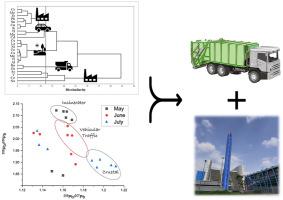Chemosphere ( IF 8.8 ) Pub Date : 2020-11-24 , DOI: 10.1016/j.chemosphere.2020.129091 Daniele Ziegler , Mery Malandrino , Claudia Barolo , Gianpiero Adami , Milena Sacco , Francesco Pitasi , Ornella Abollino , Agnese Giacomino

|
A municipal solid waste incinerator (MSWI) was installed in a peripheral area of the city of Turin. In this study, we evaluated the contribution of this plant to the massive concentration of PM10, to its chemical composition and to the distribution of the lead isotopes during the start-up phase.We assessed the inorganic composition of PM10 collected in the vicinity of the Turin incinerator by inductively coupled plasma atomic emission spectroscopy (ICP-AES), magnetic sector inductively coupled plasma mass spectrometer (SF-ICP-MS) and ion chromatography (IC). The lead isotope ratios in PM10 samples were determined by SF-ICP-MS by a method developed and optimized using experimental design approach.Element trends and data chemometric treatment evidence that the vehicular traffic, increased in this area due to the opening of the MSWI plant, and, to a lesser degree, the direct incinerator emissions influence As, Cd, Cr, Cu, Ba, Mo, Pb, Sn and Zn concentrations. As a whole, however, the element concentrations in PM10 and the Enrichment Factors (EFs) were comparable with the values reported for other urban sites and target pollutant concentrations of MSWI emissions, namely Cd, Cr, Cu and Pb, were lower than in PM10 emitted from older MSWIs. This confirms that incinerators of new installation have a lower impact on atmospheric PM10 composition thanks to stricter current legislation and up-to-date technologies. The lead isotope ratios investigation allowed to distinguish the diverse sources (crustal, vehicular traffic and MSWI) that influence lead concentration in PM10 collected near incinerator during start-up phase.
中文翻译:

焚烧炉启动阶段对大气PM 10无机成分和铅同位素比的影响
在都灵市的外围地区安装了市政固体废物焚烧炉(MSWI)。在这项研究中,我们评估了该植物在启动阶段对PM 10的大量浓度,其化学成分和铅同位素分布的贡献。我们评估了附近收集的PM 10的无机成分。电感耦合等离子体原子发射光谱法(ICP-AES),磁区电感耦合等离子体质谱仪(SF-ICP-MS)和离子色谱法(IC)对都灵焚化炉进行了分析。PM 10中的铅同位素比通过使用实验设计方法开发和优化的方法,通过SF-ICP-MS测定样品。元素趋势和数据化学计量处理证据表明,由于MSWI工厂的开放,该地区的车辆流量增加了焚烧炉的直接排放程度会影响砷,镉,铬,铜,钡,钼,铅,锡和锌的浓度。但是,从总体上看,PM 10和富集因子(EFs)中的元素浓度与其他城市地区报告的值相当,MSWI排放的目标污染物浓度(Cd,Cr,Cu和Pb)低于较旧的MSWI排放的PM 10。这证实了新安装的焚化炉对大气PM 10的影响较小组成得益于更严格的现行法规和最新技术。铅同位素比研究可以区分启动阶段焚化炉附近收集的PM 10中铅浓度的不同来源(地壳,车辆交通和MSWI)。


























 京公网安备 11010802027423号
京公网安备 11010802027423号